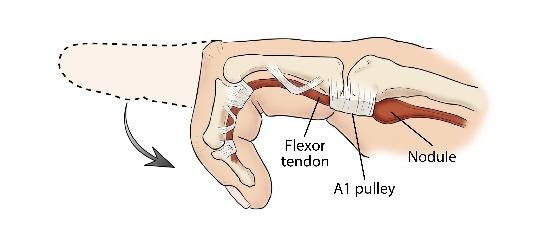Trigger Finger
What is Trigger Finger?
Trigger finger is a condition that causes pain, stiffness, and the feeling of ‘locking or catching’ when you bend and straighten your finger. The condition is also known as “Steno sing tenosynovitis.” When you have a trigger finger, your A1 pulley (A band of tissue that holds the tendon near the bone with movement) becomes inflamed or thickened causing the flexor tendon (long cord-like tissue that attaches the muscles in the forearm to the bones of the finger to allow you to bend your finger) to have difficulty moving through a tunnel created by the tendon sheath (tissue surrounding the tendon creating a tunnel to aid in gliding smoothly with movement). The flexor tendon also becomes inflamed over time. This leads to the formation of a nodule or lump of tissue that gets stuck at the pulley, requiring more force to pull it through. Imagine putting on a tight turtle-neck and really having to pull on the sweater to get your head through. This is what it is like to push the tendon through the pulley when it is inflamed. The ring finger and thumb are most often affected by trigger finger, but it can occur in other fingers also. When it occurs in your thumb, it is referred to as a “trigger thumb.”

The anatomy of the affected area in the trigger finger includes the flexor tendons, the tendon sheath, and the A1 pulley. As defined above, the flexor tendons are long cord-like tissue that attaches the muscles in the forearm to the bones of the finger in order to allow you to bend your finger. The tendon sheath is the tissue surrounding the tendon creating a tunnel to aid in gliding smoothly with the movement. The A1 pulley is a band of tissue that holds the tendon near the bone with movement. Please see the figure above for a visual of these structures.
Factors Placing People at Heightened Risk for Developing Trigger Finger:
- Medical conditions such as Arthritis
- Aging
- Gender, females are more likely to develop trigger finger than males
- Post-surgical complications, such as post carpal tunnel release
- Repetitive strain injury caused by completing the same motion repetitively
- Typing
- Manual labor
- Being on medications that cause inflammation
How is Trigger Finger Diagnosed?
Trigger fingers can be diagnosed by your doctor through a physical exam of how the hand moves, palpation of the nodule, and through the symptoms present including locking of the finger and pain.
What to Look For:
- A nodule at the base of your finger on the palm side
- A ‘catching or locking’ sensation with movement
- The finger getting ‘stuck’ when you are trying to straighten it
- Pain when you bend or straighten your finger
- Stiffness in your finger in the morning
How can an Occupational Therapist Help with Trigger Finger?
An Occupational Therapist can help by giving you preventative strategies and stretches if you work in a high-risk occupation. They can educate you on positions to avoid and how to complete your job with decreased risk of injury. When you begin experiencing early symptoms, they can recommend exercises, stretches, and how to manage pain and inflammation. They can also recommend orthoses to decrease symptoms. A small orthosis that blocks the joint at the base of your finger from moving is a great option. An Occupational Therapist can fabricate you one of these. At times, it may be too severe for Occupational Therapy intervention and require medical management, including a steroid injection. Occupational Therapists can also help after surgery, to ensure you heal correctly. They can also help you regain your strength and functional use of your hands.
If you feel you are already experiencing symptoms, you can contact your physician and request occupational therapy. The earlier you receive the intervention, the better the prognosis (outlook) for non-surgical intervention to be effective.
For More Information please visit the following websites:
https://orthoinfo.aaos.org/en/diseases–conditions/trigger-finger





